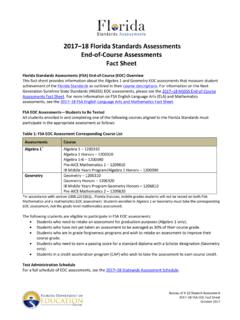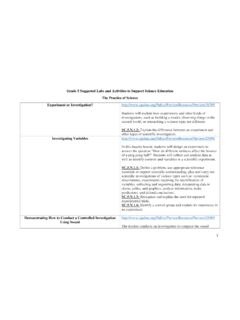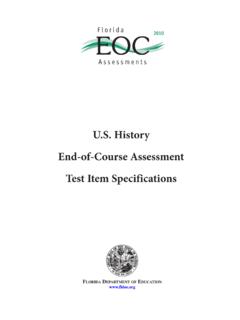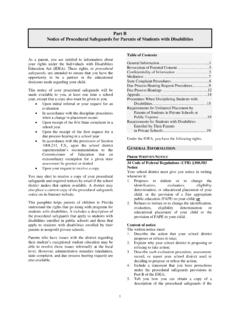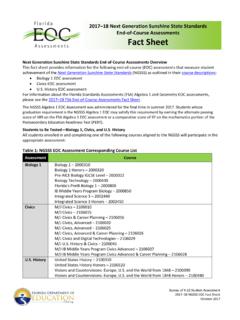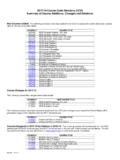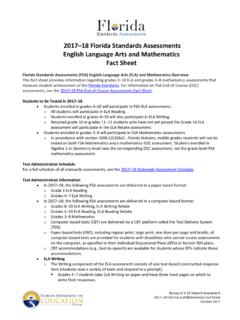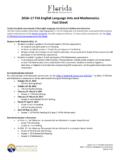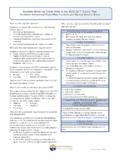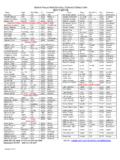Transcription of Tools for Teacher Evaluation - fldoe.org
1 Tools for Teacher Evaluation Dr. paula Bevan, 2010 2 OVERVIEW OF THE Teacher Evaluation PROCESS Novice Experienced Independent Supported Growth Intensive Support Membership First 3 years of teaching or, for experienced teachers, first year of service in this district New to teaching position=3 years New to the district=1 year Any Teacher who is not a novice and not in intensive support Designation into heterogeneous Cohorts A, B, or C by, and at the discretion of, the Teacher supervisor At the discretion of the Teacher supervisor based on objective collected evidence of, but not limited to.
2 Persistent unsatisfactory performance in one or more of the components of professional practice. Description of Assessment Observation-based assessment only: a minimum of one formal and two informal or walk-through observations per semester for two or four semesters in addition to artifact examinations, Teacher self-assessment and Teacher interviews Observation-based annual assessment, once every three years, (or more often at the discretion of the Teacher supervisor based on objective evidence related to the standards of practice) consisting of a minimum of two formal and two informal or walk-through observations per year in addition to artifact examination, Teacher self-assessment and Teacher interviews Formative assessment self-directed growth plan incorporating existing district formative assessment supports , to occur twice in every three-year cycle and driven by student assessment data.
3 (See chart below) Note: This is NOT optional. Participants may not elect formal assessment instead. Individualized team-based, collaboratively-designed improvement plan, including timeline, and targeted component(s) of practice. Evidence of improvement is necessary and will be articulated as part of the plan. Description of Process Step 1: Self-assessment by the Teacher on all 22 rubric components at start of school year. Teacher shares self-assessment with supervisor. Step 2: Collection of evidence, all year, on all 22 components as appropriate, through: Formal(full lesson) 1. Pre-observation lesson plan 2.
4 Observation for D2,D3 3. Teacher Self-assessment 4. Collaborative Evaluation informal (lesson portion or walk-through) observations multiple visitations by supervisor some announced, some unannounced use standardized evidence collection form post-conference with Teacher preceded by Teacher s self-assessment for announced, observed lesson Step 3: Mid-year Teacher self assessment all 22 components, based on relevant evidence, then corroborated or corrected by supervisor. Step 4 : Collaborative summative assessment with supervisor. Teacher initiates the summative assessment; supervisor corroborates or corrects.
5 Tentative component goal selection for upcoming Step 1: Self-assessment on all 22 rubric components based upon student achievement data and other relevant evidence. Teacher selects one component as goal for growth, based on the component that, when improved, would provide greatest impact on student achievement. Teacher shares self-/target component with supervisor. Step 2: Teacher designs project to improve target component, including timeline, activities and evidence to be produced, and incorporating district formative assessment services wherever applicable. Step 1: (Supervisor) Identification of the specific deficiencies/components of the Framework which are unsatisfactory and in need of improvement: List the components of the Framework where performance is persistently at the Unsatisfactory level and attach relevant observation evidence/documents.
6 Step 2: (Supervisor) Identification of the specific qualities and evidence needed to indicate satisfactory performance in the target components: Refer to the rubrics and articulate specific outcomes that can be measured. Dr. paula Bevan, 2010 3 directed professional growth year (experienced teachers only). Step 3: Teacher invites a colleague to review project for suggestions, then presents it to supervisor for suggestions, support and approval. Step 4: Teacher implements project; supervisor conducts informal checks for progress as appropriate throughout the year and provides oral feedback as degree of progress.
7 Step 5: Teacher collects relevant evidence of project completion and goal achievement. Completes self-assessment on 22 components and shares w/ supervisor. Collaborative summative assessment completed with evaluator. (Pass/fail recommended) Step 3: (Supervisor) An established timetable for the required improvement in performance: List the date by which performance outcomes must be achieved, with sub-targets. Step 4: ( Teacher ) Design of activities that will move teaching practice toward satisfactory performance in the target components including district formative assessment supports where applicable Step 5: ( Teacher ) List of those persons, if any, who will help design and implement the plan and formatively monitor progress.
8 (Colleagues provide formative support, not Evaluation ). Step 6: ( Teacher ) Identification of multiple resources provided by the district to help the Teacher succeed Step 7: (Supervisor) Approval of the plan with or without changes, permission to begin implementation. Frequency of Evaluation Minimum one formal and two informal per semester for 1 or 2 years (2 or 4 formal observations) Year-long cycle to occur once every three years; one formal and two informal per year, every three years Year- long cycle to occur twice every three years Length of plan shall be not more than one year and not less than one semester.
9 Wwritten, evidence-based feedback weekly throughout the implementation of the plan. Dr. paula Bevan, 2010 4 Cycle I: Formal Evaluation Dr. paula Bevan, 2010 5 The Process of Teacher Evaluation CYCLE I: FORMAL Evaluation PROCESS Step 1: Evidence collection, Domains 1 and 4: The Lesson Plan Announced Observations: For announced observations, the Teacher completes Evidence Collection Form #1: Domains 1 and 4, attached, (electronically, preferably) and sends it to evaluator two days prior to announced visit. Evaluator reads the plan, provides feedback to the Teacher , (electronically, preferably) and asks any clarifying questions as necessary, as well as any other questions that will provide helpful evidence prior to the A face-to-face pro-observation conference in addition to the above document-sharing is optional, but not necessary.
10 This plan becomes evidence for Domains 1 and 4. Unannounced Observations: No lesson plan or pre-observation conference is required. Items contained on Form #1 may, however, be discussed after the lesson and relevant evidence collected. Step 2: Evidence Collection, Domains 2 and 3 Announced and unannounced: Evaluator conducts observation of practice, collecting evidence using the appropriate attached document: Evidence Collection Form #2A: Observation of full lesson Evidence Collection Form #2B: Walk-through or lesson portion Evaluator shares a copy of the evidence with the Teacher who is always invited to add to, or correct, the evidence as necessary so that the record of the observation is as accurate as possible.
